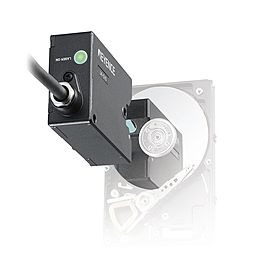Keyence’s LK-G portfolio of Laser Displacement Sensors has combined accuracy, high resolution and more than 7” long range for providing top grade measurement performance. Its measurement performance exceeds that of conventional displacement sensors by virtue of its 0.01µm resolution, high sampling speed of 50 kHz and ±0.03% high accuracy
These sensors offer better stability with inline applications that need averaging of data, besides applications relating to vibrating, fast moving or rotating targets. Its accuracy surpasses that of the traditional CCD laser displacement sensors.
 Keyence laser displacemen tsensor
Keyence laser displacemen tsensor
They utilize a specialized Linearized CCD (Li-CC) that was created by Keyence particularly for sensor applications, for outputting the light’s position in a pixel to achieve twice the accuracy of traditional models. In addition, its proprietary design delivers 25 times more speed and 10 times more sensitivity of traditional systems.
Keyence has also created a novel light-receiving module that focuses reflected light at the Li-CCD. A high-accuracy lens system from Ernostar has significantly lowered spot distortion due to aberrations. A highly rigid die-cast body reduces deviations due to change in temperature.
The Active Balanced Laser control Engine (ABLE) Keyence technology can sense surface conditions at the target for enabling adjustment of the intensity of laser light to an optimal level, resulting in a light intensity range that is 13,000 wider than before. The ABLE ensures that surface coatings, color, and reflections do not affect the performance of the LK-G.
ABLE offers distinctive measurement performance on various targets. These targets include metal, black-rubber, and mirror-surfaced metal targets. A Keyence-created Real Peak Detection (RPD) algorithm can cancel the diffused light due to the reflections of the laser beam reflections in translucent targets. RPD facilitates obtaining accurate measurements on translucent type of targets, such as plastic and PCB. Other transparent materials include a broad glass materials range and LCD cover glass.